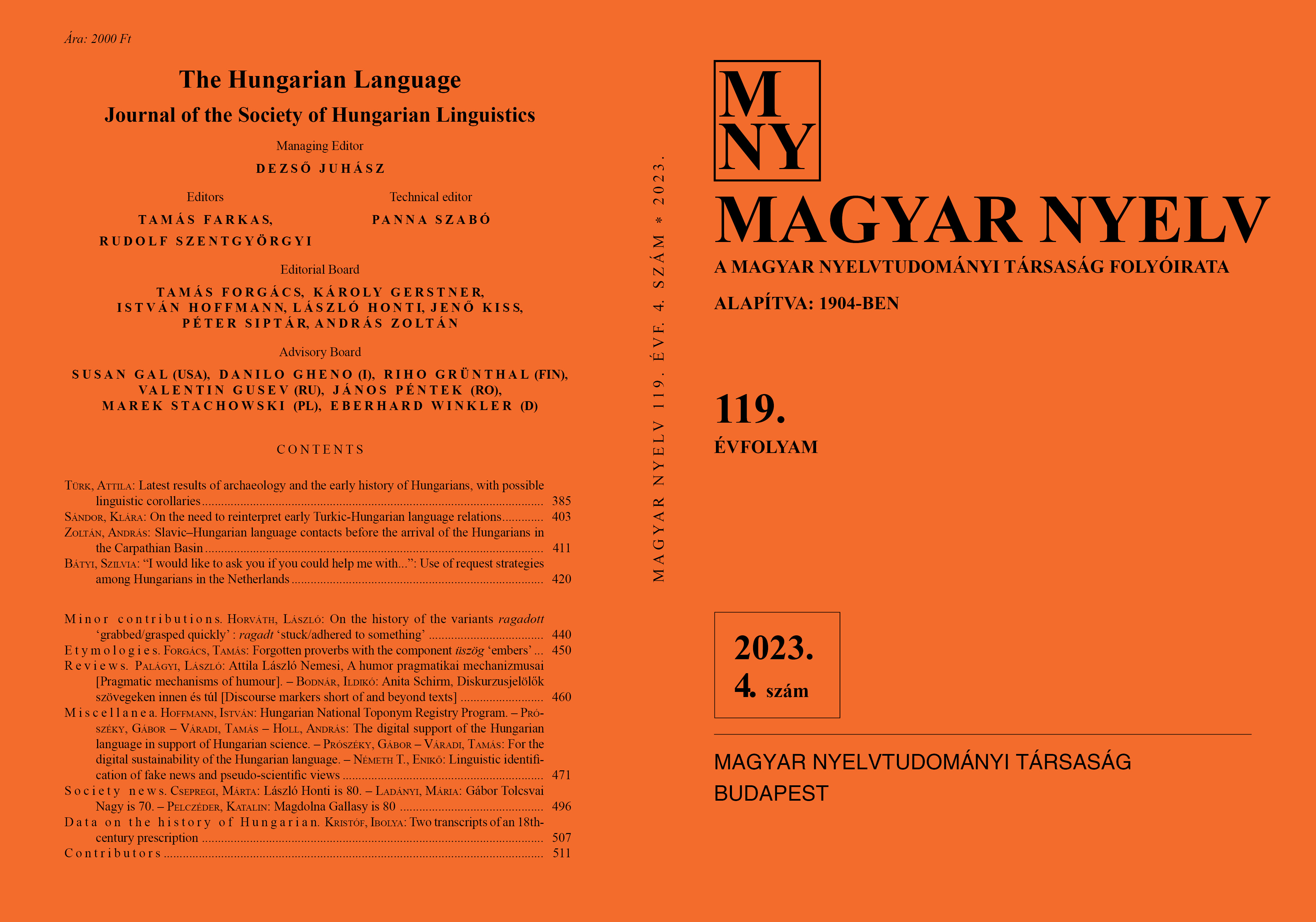Latest results of archaeology and the early history of Hungarians, with possible linguistic corollaries
DOI:
https://doi.org/10.18349/MagyarNyelv.2023.4.385Keywords:
Early history of the Hungarians, archaeology, Subbotsi-type sites, Volga–Southern Ural region, Hungarian Conquest periodAbstract
Studies on the early history of the Hungarians are bedevilled by the lack of reliable written sources and therefore archaeology plays a crucial role as discipline with a rapidly growing source material. It must also be emphasised that archaeology is characterised by a significant broadening of research methods, principally owing to the advances in bioarchaeological research. One of the most significant archaeological results in recent years has been the dynamic increase in the number of Subbotsi-type sites identified in the Dniester region, generally equated with the Etelköz settlement territory of the written sources. 10–12 Subbotsi sites are currently known along the middle reaches of the Dnieper, a region where the connections between the ancient Hungarians and their neighbours, mainly the northern, Slavic territories as well as the Byzantine cultural province in the Crimea are well documented. In addition to their chronological position, the Subbotsi finds also correlate well with the image of the ancient Hungarians in the Muslim written sources of the 9th century. Farther to the east, the broader area of the Samara Bend of the Volga and of the southern Urals are the most important regions in terms of Hungarian ethnogenesis. As a working hypothesis, we may contend that the earliest archaeological traces of the ancient Hungarians can be assumed east of the Ural Mountains, in the Trans-Ural region. The ancient Hungarians most likely began their westward migration at the beginning of the 9th century: they soon crossed to the left bank of the Volga and their territory extended to the border of Volga Bulgaria. Some groups remained in the Lower Kama region, while other groups migrated westward before the 830s and then settled in the northern foreland of the Black Sea. Between the 890s and the beginning of the 10th century, Subbotsi-type artefacts disappear from this region and make their appearance in the Carpathian Basin, where their further development can be observed.
Downloads
Published
Issue
Section
License
Copyright (c) 2023 Attila Türk

This work is licensed under a Creative Commons Attribution-NonCommercial-NoDerivatives 4.0 International License.
Magyar Nyelv is a Diamond Open Access periodical. Documents can be freely downloaded and duplicated in an electronic format, and can be used unchanged and with due reference to the original source. Such use must not serve commercial purposes. In the case of any form of dissemination and use, Hungarian Copyright Act LXXVI/1999 and related laws are to be observed. The electronic version of the journal is subject to the regulations of CC BY-NC-ND (Creative Commons – Attribution-NonCommercial-NoDerivatives).
The journal permits its authors, at no cost and without any temporal limitation, to make pre-print copies of their manuscripts publicly available via email or in their own homepage or that of their institution, or in either closed or free-for-all repositories of their institutions/universities, or other non-profit websites, in the form accepted by the journal editor for publication and even containing amendments on the basis of reviewers’ comments. When the authors publicize their papers in this manner, they have to warn their readers that the manuscript at hand is not the final published version of the work. Once the paper has been published in a printed or online form, the authors are allowed (and advised) to use that (post-print) version for the above purposes. In that case, they have to indicate the exact location and other data of the journal publication. The authors retain the copyright of their papers; however, in the case of an occasional secondary publication, the bibliographical data of the first publication have to be included.



